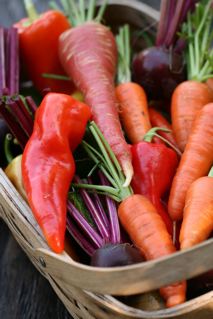 Warmer weather usually means more rain storms and thus the potential for more rainbows as well.
Warmer weather usually means more rain storms and thus the potential for more rainbows as well.
Virtually all of us should be aiming to consume a “Rainbow of Color” from nature’s color wheel when it comes to fruits & veggies.
There are many health benefits associated with the colors of the rainbow nature so graciously provides, and particularly for those discussing prostate cancer prevention, incidence & progression, treatment, and survivorship as noted in the 4 part series we started late last month and will be continuing with this month.
Beyond their beneficial vitamin content, consider the rich antioxidant & anti-inflammatory content of some deeply colored fruits & vegetables.
How familiar are you with nature’s rainbow of fruits & veggies when it comes to matters of prostate cancer and actually overall health for anyone?
(Photo of basket of organic vegetables courtesy of Dahlia via rgbstock.com).
Here are some examples:
BLUE/PURPLE food items are typically rich in anthocyanins. Examples of good choices from this color group would include blueberries, purple eggplant, figs, grapes/raisins, and plums/prunes;
GREEN food items are often rich in vitamin K, potassium, sulforaphane, isothiocyanates, glucosinolates, indoles such as indole-3 carbinol (think of cruciferous vegetables) and also folate. Examples of good choices from this color group would include arugula, beet greens, bok choy, broccoli, Brussels sprouts, cabbage, cauliflower, collard greens, horse radish, kale, kohlrabi, mustard greens, radishes, rutabaga, Swiss chard, turnip greens, wasabi, and watercress. Green/yellow food items typically contain lutein and zeaxanthin. Sources include avocado, collard greens, green beans, green peppers, kale, kiwi, mustard greens and spinach; there is even some lutein in the green “skin” around the pistachio nut;
ORANGE food items are typically rich in alpha and beta carotenes. Examples of good choices from this color group would include apricots, cantaloupes, carrots, mangoes, butternut squash, pumpkin and other winter squashes, and sweet potatoes;
ORANGE/YELLOW food items contain beta-cryptoxanthin. Examples of good choices from this color group would include nectarines, oranges, papaya, and peaches; some are also sources of vitamin C and flavonoids such as lemons, limes, oranges, orange juice, peaches, pineapples, tangerines.
RED food items are rich in lycopene as well as containing phytoene, phytofluene, and vitamin E. Examples of good choices from this color group would be tomatoes/cooked tomato puree, tomato juice/vegetable juice blend, also tomato soup, pink grapefruits, and even watermelon; RED food items can also be rich in anthocyanins. Examples of good choices from this color group would include red grapes, raspberries, and strawberries;
RED/BLUE/PURPLE food items contain anthocyanins, ellagic acid, flavonoids. Examples of good choices from this color group would include berries (blackberries, blueberries, cranberries, raspberries, strawberries), eggplant with skin on, grapes and grape juice (even some red wines), cherries, plums/prunes, and pomegranates, raisins, strawberries;
WHITE/GREEN food items typically contain anthoxanthins such as allyl sulfides (think of alliums containing alliicin). Examples of good choices from this color group of food items would include asparagus, chives, garlic, leeks, mushrooms, onions, parsnips, and shallots;
and
YELLOW/GREEN food items are rich in lutein and zeaxanthin. Examples of good choices from this color group of food items would include avocado, collard greens, green peas, honeydew mellon, spinach, and yellow corn.
Take advantage of a local Farmers Market when you see nature’s fresh bounty in abundance, or if that is not possible, then seek out good quality frozen and/or canned vegetables with no salt added and no sauces added, etc., as usually those choices can be excellent sources of these precious substances as well.

